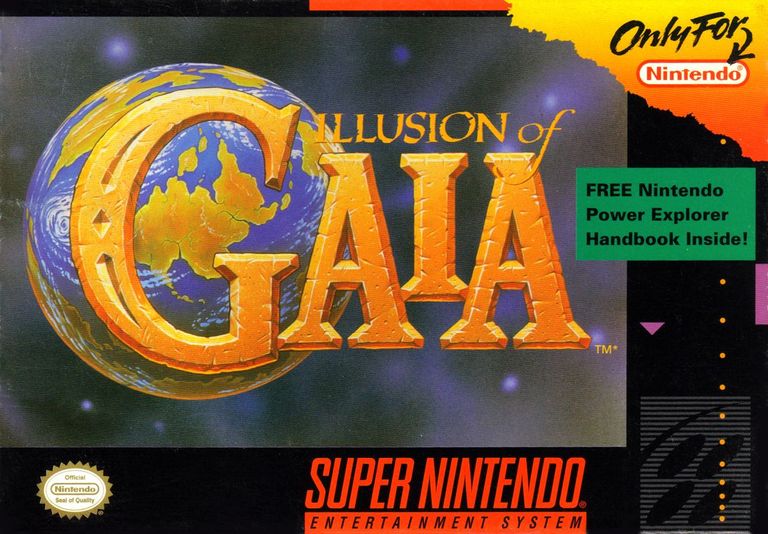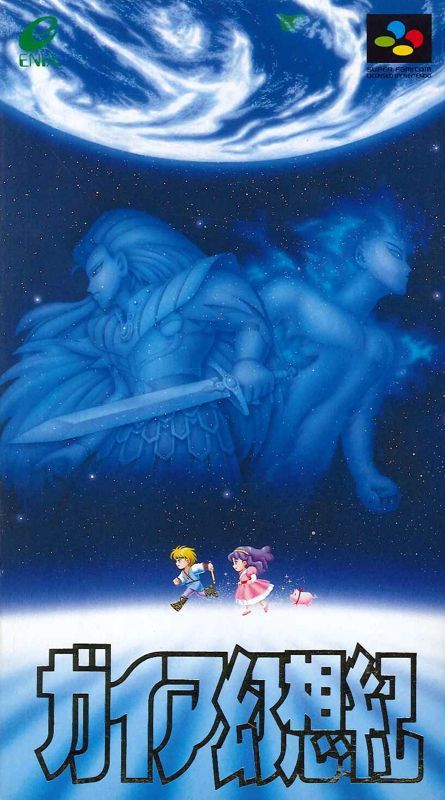
Illusion of Gaia, also known as Illusion of Time in PAL regions, is an action RPG developed by Quintet for the Nintendo/Super Famicom. It was released by Enix in Japan in 1993, and later brought to North America and PAL regions by Nintendo in 1994 and 1995.
I've always liked the Zelda video game series because it is a lot of fun to play. So why am I mentioning it in a review of Illusion of Gaia? Well, the Zelda games have been popular enough that many game companies tried to create their own versions. Even Enix took a shot at it with this Illusion of Gaia — a real-time action/adventure game for the Super Nintendo that's fun, though not without its flaws.

The Story
Venture into the shadows of an ancient civilization.
A menacing light emanates from the Chaos Comet as it threatens the planet's very existence. After fierce battles, a fragile peace is restored, but danger looms as the Chaos Comet draws near, and terrifying creatures lie in wait.
During the Age of Exploration, a boy named Will is born. Tragedy strikes when an expedition to the Tower of Babel separates Will from his father. As Will returns to South Cape, his telekinetic powers begin to awaken. With the ability to transform into two powerful warriors, Will embarks on a mission to save the planet.
Guided by the spirit Gaia, who grants him magical abilities and advice, Will must rely on his friends to battle relentless foes and decipher the puzzles hidden within ancient ruins. Only with patience and wisdom can he hope to reunite with his father and protect the world.

The Graphics and Sound
The game graphics features a standard RPG overhead view, but the characters stand out with their well-defined designs, especially compared to other games of the time. Enemies vary from one world to the next, and both bosses and locations are detailed and large enough to be visually engaging. Moving between areas is done through a Mode 7 graphic effects map, where you walk from point A to point B. However, unlike many RPGs, you don’t get to fully explore or appreciate the world due to the game’s restrictive travel mechanics. While the backgrounds can be appropriately eerie, the dungeons might feel repetitive, and the overall atmosphere can sometimes be a bit odd. Still, the graphics were impressive for their era and remain enjoyable today.
The soundtrack isn’t particularly memorable, with no standout themes for the main characters. However, it never becomes irritating or overwhelming. The sound effects are decent, and the music does a good job of setting the tone for each realm, giving them their own distinct atmosphere.
The Gameplay
Illusion of Gaia is an action RPG that that resemble the Zelda series. In the game, you play as Will, a protagonist who uses a flute as his weapon and gains psychic abilities, like the psycho dash, throughout the game. As the story progresses, you also get to control Freedan, a dark knight, and Shadow, a being made of pure energy. Each of these characters has unique abilities, and some areas can only be accessed by a specific character. This setup encourages you to switch between them, diversifying the gameplay and making the dungeons particularly enjoyable, especially in the later stages of the game.
The gameplay involves moving between towns or peaceful areas where you interact with NPCs and advance the story, and dungeons where you engage in combat and solve puzzles. The dungeons are the core of the game, featuring a mix of fighting, puzzle-solving, and using the unique abilities of Will and his allies to progress. Unlike the Zelda games doesn’t have weapon upgrades. Instead, you power up by defeating all the enemies in a particular area, which increases one of your stats. Once the enemies are defeated, they don’t respawn, so there’s no grinding in this game. The game feels more linear than most RPGs because the world map is restrictive, and you can’t revisit previous areas.
Items are relatively scarce in this game. While you can obtain healing herbs and story-related items, they aren’t a major focus. However, there are hidden items called red jewels that you can collect and trade with a collector for healing herbs or new abilities. Some of these jewels are very well hidden, and it might take a couple of playthroughs or a guide to find them all. If you manage to collect all 50, you gain access to an optional dungeon near the end of the game. Since you can’t return to previous areas, collecting all the red jewels can be challenging, adding some replay value to a game that otherwise lacks it.
Overall, Illusion of Gaia is a lot of fun to play. While the game has its flaws, its core gameplay isn’t one of them. The dungeon level design is excellent, and the difficulty level rises steadily, never becoming too easy or too hard. The weakest parts of the game are the sections between dungeons, which can feel a bit dull and disrupt the game’s flow. Despite this, the majority of the game is highly enjoyable.
The game doesn’t offer much replay value beyond the quest to collect all the red jewels. However, since it's a relatively short game, replaying it wouldn’t require a significant time commitment.
My Verdict
Any fan of action RPGs should definitely seek out this game. It is a worthwhile addition to any SNES collection. The game’s biggest strength lies in its dungeons and combat, which are truly engaging. However, its weakest points are the story and the occasional dull moments between dungeons. Despite these quirks, Illusion of Gaia still delivers a highly enjoyable experience.
Play it on the unforgettable Super Nintendo/Super Famicom or play it on an awesome emulator.
Telegram and Whatsapp